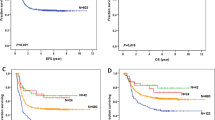Abstract
Mutations in the fms-like tyrosine kinase 3(FLT3) gene containing an internal tandem duplication(@#@ FLT3/ITD@#@) or mutations in the nucleophosmin 1 gene(NPM1) are thought to be prognostic indicators in acute myeloid leukemia (AML). Previous studies suggested that FLT3/ITD mutation indicates a poor prognosis and thatNPM1 mutation indicates a more favorable one, but these studies were often performed with selected patient populations. We investigated the clinical significance of these mutations at our institution with an unselected group of patients with newly diagnosed AML. This group included patients ≥60 years old and those with a poor performance status. Using polymerase chain reaction and sequencing analyses, we detected FLT3/ITD mutations in 12 patients (20.0%) andNPM1 mutations in 7 patients (11.7%) among a group of 60 patients. There was a nonsignificant trend for FLT3/ITD mutation to be associated with a poorer predicted overall survival (OS) probability in this population. In contrast, OS was significantly higher in patients with wild-typeNPM1 than in patients withNPM1 mutation, both for all AML patients and for AML patients with a normal karyotype. In this general and unselected AML patient population,NPM1 mutation was not a prognostic indicator of a favorable outcome.
Similar content being viewed by others
References
Mrózek K, Marcucci G, Paschka P, Whitman SP, Bloomfield CD. Clinical relevance of mutations and gene-expression changes in adult acute myeloid leukemia with normal cytogenetics: are we ready for a prognostically prioritized molecular classification?Blood. 2007;109:431–448.
Kiyoi H, Naoe T. Biology, clinical relevance, and molecularly targeted therapy in acute leukemia with FLT3 mutation.Int J Hematol. 2006;83:301–308.
Falini B, Mecucci C,Tiacci E, et al, for the GIMEMA Acute Leukemia Working Party. Cytoplasmic nucleophosmin in acute myelogenous leukemia with a normal karyotype.N Engl J Med. 2005;352:254–266.
Kiyoi H, Towatari M, Yokota S, et al. Internal tandem duplication of the FLT3 gene is a novel modality of elongation mutation which causes constitutive activation of the product.Leukemia. 1998;12:1333–1337.
Yanada M, Matsuo K, Suzuki T, Kiyoi H, Naoe T. Prognostic significance of FLT3 internal tandem duplication and tyrosine kinase domain mutations for acute myeloid leukemia: a meta-analysis.Leukemia. 2005;19:1345–1349.
Kottaridis PD, Gale RE, Frew ME, et al. The presence of a FLT3 internal tandem duplication in patients with acute myeloid leukemia (AML) adds important prognostic information to cytogenetic risk group and response to the first cycle of chemotherapy: analysis of 854 patients from the United Kingdom Medical Research Council AML 10 and 12 trials.Blood. 2001;98:1752–1759.
Thiede C, Steudel C, Mohr B, et al. Analysis of FLT3-activating mutations in 979 patients with acute myelogenous leukemia: association with FAB subtypes and identification of subgroups with poor prognosis.Blood. 2002;99:4326–4335.
Borer RA, Lehner CF, Eppenberger HM, Nigg EA. Major nucleolar proteins shuttle between nucleus and cytoplasm.Cell. 1989;56:379–390.
Dumbar TS, Gentry GA, Olson MO. Interaction of nucleolar phosphoprotein B23 with nucleic acids.Biochemistry. 1989;28:9495–9501.
Tarapore P, Okuda M, Fukasawa K. A mammalian in vitro centriole duplication system: evidence for involvement of CDK2/cyclin E and nucleophosmin/B23 in centrosome duplication.Cell Cycle. 2002;1:75–81.
Sipos K, Olson MO. Nucleolin promotes secondary structure in ribosomal RNA.Biochem Biophys Res Commun. 1991;177:673–678.
Suzuki T, Kiyoi H, Ozeki K, et al. Clinical characteristics and prognostic implications ofNPM1 mutations in acute myeloid leukemia.Blood. 2005;106:2854–2861.
Boissel N, Renneville A, Biggio V, et al, for the Acute Leukemia French Association (ALFA). Prevalence, clinical profile, and prognosis of NPM mutations in AML with normal karyotype.Blood. 2005;106:3618–3620.
Schnittger S, Schoch C, Kern W, et al. Nucleophosmin gene mutations are predictors of favorable prognosis in acute myelogenous leukemia with a normal karyotype.Blood. 2005;106:3733–3739.
Döhner K, Schlenk RF, Habdank M, et al, for the AML Study Group (AMLSG). Mutant nucleophosmin(NPM1) predicts favorable prognosis in younger adults with acute myeloid leukemia and normal cytogenetics: interaction with other gene mutations.Blood. 2005;106:3740–3746.
Verhaak RG, Goudswaard CS, van Putten W, et al. Mutations in nucleophosmin(NPM1) in acute myeloid leukemia (AML): association with other gene abnormalities and previously established gene expression signatures and their favorable prognostic significance.Blood. 2005;106:3747–3754.
Thiede C, Koch S, Creutzig E, et al, for the Deutsche Studieninitiative Leukämie (DSIL). Prevalence and prognostic impact ofNPM1 mutations in 1485 adult patients with acute myeloid leukemia (AML).Blood. 2006;107:4011–4020.
Miyawaki S, Sakamaki H, Ohtake S, et al, and the Japan Adult Leukemia Study Group. A randomized, postremission comparison of four courses of standard-dose consolidation therapy without maintenance therapy versus three courses of standard-dose consolidation with maintenance therapy in adults with acute myeloid leukemia: the Japan Adult Leukemia Study Group AML 97 Study.Cancer. 2005;104:2726–2734.
Asou N, Kishimoto Y, Kiyoi H, et al, for the Japan Adult Leukemia Study Group. A randomized study with or without intensified maintenance chemotherapy in patients with acute promyelocytic leukemia who have become negative forPML-RARα transcript after consolidation therapy: the Japan Adult Leukemia Study Group (JALSG) APL97 study.Blood. 2007;110:59–66.
Grimwade D, Walker H, Oliver F, et al, on behalf of the Medical Research Council Adult and Children’s Leukaemia Working Parties. The importance of diagnostic cytogenetics on outcome in AML: analysis of 1,612 patients entered into the MRC AML 10 trial.Blood. 1998;92:2322–2333.
Kiyoi H, Naoe T, Nakano Y, et al. Prognostic implication ofFLT3 andN-RAS gene mutations in acute myeloid leukemia.Blood. 1999;93:3074–3080.
Gale RE, Hills R, Kottaridis PD, et al. No evidence that FLT3 status should be considered as an indicator for transplantation in acute myeloid leukemia (AML): an analysis of 1135 patients, excluding acute promyelocytic leukemia, from the UK MRC AML10 and 12 trials.Blood. 2005;106:3658–3665.
Bornhäuser M, Illmer T, Schaich M, Soucek S, Ehninger G, Thiede C, and the AML SHG 96 Study Group. Improved outcome after stem-cell transplantation in FLT3/ITD-positive AML.Blood. 2007;109:2264–2265.
Chou WC, Tang JL, Lin LI, et al.Nucleophosmin mutations inde novo acute myeloid leukemia: the age-dependent incidences and the stability during disease evolution.Cancer Res. 2006;66:3310–3316.
Author information
Authors and Affiliations
Corresponding author
About this article
Cite this article
Suzuki, R., Onizuka, M., Kojima, M. et al. Prognostic significance ofFLT3 internal tandem duplication andNPM1 mutations in acute myeloid leukemia in an unselected patient population. Int J Hematol 86, 422–428 (2007). https://doi.org/10.1007/BF02984000
Received:
Revised:
Accepted:
Published:
Issue Date:
DOI: https://doi.org/10.1007/BF02984000




